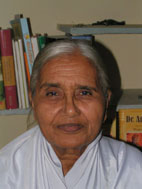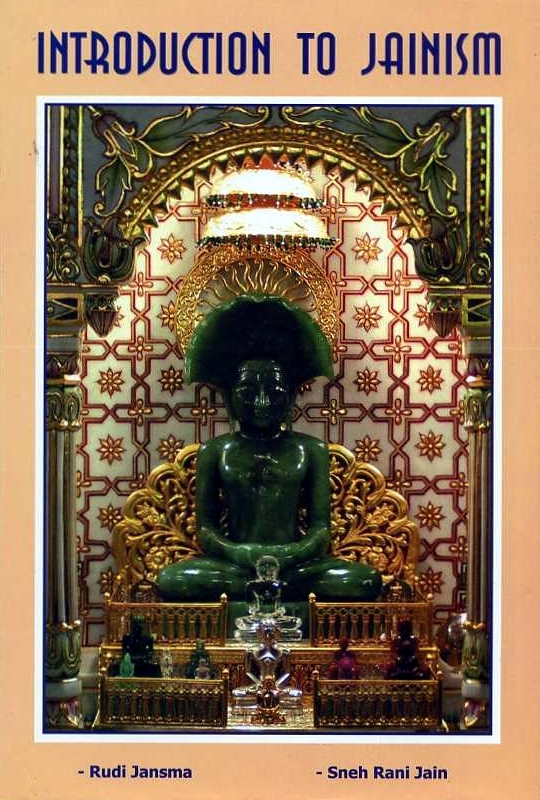Jainism does not have an explicit doctrine of evolution, and among Jains themselves it is a point of discussion whether one can speak of an evolution - whether gradual or punctuated - of inner qualities from less developed to more developed forms.
Jains may never have given real attention to this question, and in general many take the attitude that “what you (in the West) think is your business, is of no concern to us; but let us go our own way.” Many regard western scientific theory as something that may be a nice occupation, but is by nature evanescent subject to constant change, and they prefer to focus on the knowledge of all ages. Science is still very far from knowing everything. On the other hand, every individual spiritual seeker has to go a long, long way to develop his mind and inner faculties to reach full understanding of the deepest meaning of the spiritual doctrines given to humankind by those who were far ahead of the average. Until that time no human being can claim to know the truth. There may be many truths and insights hidden in the doctrines of Jainism (or any genuine thought system for that matter) whose meaning even Jain scholars or monks have not yet glimpsed.
Some Jains however try to compare their own teachings with the theories of the occident, and I - as a non-Jain - have done the same thing. When studying Jain philosophy there are to my opinion enough clues to defend the view that Jainism has an implicit doctrine of evolution, and in such a way that world culture can draw much benefit from it.
The mainstream belief among Jains is that the soul, depending on its vibrations and resultant karma, can haphazardly move up and down and horizontally through all higher and lower forms of existence. Still final liberation from the cycle of joy and suffering can only be reached through the human kingdom - and in this respect Buddhism, Theosophy and Jainism agree. The theosophical system teaches that the soul after many incarnations in the human kingdom - long after having left behind the animal and lower kingdoms - can awaken step by step to buddhic consciousness and thus can become a Buddha - a fully awakened human being which can choose immediate nirvana or to postpone nirvāna to help others still struggling on the spiritual path.[57] Full spiritual awakening, enlightenment or liberation can only be accomplished by right thinking and action, such as complete nonviolence and self-purification. During these efforts high yogic powers may develop, such as spiritual clairvoyance, knowledge of the thoughts of others (when the soul has acquired sufficient purity to be unable to misuse its power) the power to see karmic relations between someone’s successive incarnations, and, above all, an infinitely spiritual and wise compassion. Finally one reaches what the Jains call kevalajñāna, omniscience: the soul reaches for ever its full unlimited blossoming. This is evolution in the true sense. All that our being always contained but could express only partially is than fully unfolded and manifest to the individual consciousness. That essence is our soul - every soul of every form of life –, which is immortal and uses one form after the other on its long pilgrimage through nature.
A Jain might say that within this endless oscillation between high and low forms of existence the chance of being born as a human is very small. But in any of these forms of existence we must have had the opportunity to attract those karmas, which gave us our present existence as a human! And when we finally become humans, most of us spoil the opportunity. How many of us really choose a spiritual life and, turning away from all lower aspects of our nature, direct ourselves exclusively towards the divine?
Still there are enough indications within the Jain teachings that the real state of affairs differs from the above exoteric opinion. One of the questions, which are of interest in this connection, is the exhaustion of the number of souls. Souls reach liberation, the highest state of being, never to return to a lower state. If there were no supply from below, one day all souls would have reached liberation - and because there has been no beginning to existence as the Jains teach, it would be impossible to explain why there are still non-liberated souls in the universe. However they teach also that there is an infinite number of nigodas (“microorganisms” in a sense), which find themselves in the lowest state of consciousness. They have one sense only: that of touch or feeling. But how did they reach their present karmic condition? Within the framework of karma theory this is only possible if there is a stage, which precedes that of the nigodas. Though it is believed that many nigodas[58] can never leave their present stage, there is another class, which can. So when these graduate to a higher realm, they are “lost” for the nigoda realm. At the other end there are souls who reach liberation for ever, so that at least on the average evolution is progressive. This average is determined by the totality of the conditions of all individuals. So we can also say that there is an average evolutionary progress for each individual. If however there is an infinite number of nigodas and liberation is the absolute end to the pilgrimage of the soul, there must be an infinite number of liberated souls. In between there is a continuously upward moving stream of living beings. Prof. Padmanabh S. Jaini of Berkeley discusses the question of evolution in his article Karma and the Problem of Rebirth in Jainism and states among other arguments: “... every soul is said to exist along a virtual continuum of consciousness, from the minimal but ineradicable trace of awareness (nitya-udghātita-jñāna) possessed by a nigoda to the omniscience of a siddha [one who has achieved liberation]... we have here a model which is both linear and evolutionary in its conception.” Every being on earth (and elsewhere) seems to have some instinct for progress in agreement with the direction, which the inner being has chosen and in agreement with its previous desires. Despite an endless number of setbacks on a path of trying and failing, this effort to progress always remains a dominant vibration of the soul, as a result of which all souls will ultimately be driven to the human condition, and finally to liberation. Progressive evolution in nature follows as a logical consequence. Therefore Jain philosophy contains concepts for this. The concept of bhavyatva means “the power to reach liberation,” and is an inherent quality of the soul. This quality has always been in the background, waiting for the moment it would be awakened to one’s consciousness. We should always bear in mind the fundamental point that the soul by its own nature is pure, omniscient and all-compassionate, and that it is only the individual consciousness of the karmic vehicle of the soul - i.e. every individual manifestation of consciousness - that differs for every living being and is limited in extent. The experience of suffering which we constantly undergo is the result of deception or darkened clarity - and this we call ignorance. Therefore the soul itself is ready to radiate its undaunted energy for the wellbeing, spiritual progress and liberation of the suffering consciousness. When, thanks to the right karmic conditions, the receptive center of consciousness has reached a state of preparedness, the “light” may suddenly break through and bend the propensities of the consciousness irreversibly in the direction of a spiritual goal, and that is the knowledge of the Soul or Self.
It is however not the case that bhavyatva, the power to liberation, takes us by the hand and leads us to salvation. Bhavyatva initiates the process and makes the spiritual pilgrim aware that there is a purpose to life, but that one must climb the path towards Truth by one’s own strenuous efforts, by living a life of purity, steadfastness and self-control. The path of spiritual growth involves the unfolding of the qualities of the soul as the karmic obstructions are removed.
Thus, from an evolutionary perspective, we may distinguish two phases: the first phase in which the soul clothes itself in innumerable “garments” (bodies) so that it can undergo experiences in all realms of nature in agreement with the karmas it has attracted and embraced. It develops one sense-organ, then two, three, four, five, and a mind, until the point has been reached where the soul becomes receptive to the influence of bhavyatva. At that moment the second phase begins: that of self-directed evolution.
Still another concept in relation to evolution and the path the disciple has entered is yathā-pravritti-karana, which means “beginning cause.” It is the urge which is felt even in the most primitive consciousness to liberate itself from the chains of bondage and karmic obstacles. This quality too belongs to the inherent nature of the soul. In humans this energy acquires a very special meaning: it is this urge, this energy, which a person can choose at the beginning of the path of self-conscious, self-directed evolution; it temporarily pushes aside most karmas, and thus brings the consciousness face to face with all individual karmas which obstruct the vision and freedom of the soul. This gives to the aspirant the hope and courage to wage the battle, which will lead to victory and Jinahood.
Thus, if we consider these two concepts of bhavyatva and yathāpravrittikarana –i.e. the ever-present inherent power of liberation, and the power to face the inner “enemy” which we are bound to conquer - we may, I think, conclude that there is an inherent doctrine of evolution in Jainism. Thanks to these two qualities of the soul the pilgrimage of the soul moves predominantly in an upward direction. All changes of form - parināma - in the vehicles of the soul continuously move in the direction of greater accomplishment, upwards through the realms of nature towards perfection.
The inherent qualities, i.e. knowledge, joy, energy, and compassion of the soul - which by nature is immortal - can never be extinguished. Temporarily they can be obscured by the karmic “molecules“ sticking to them, but in the end the aspirant soul, with all its noble qualities, will always conquer and thus the highest goal of evolution will surely be reached by every one of us.
 Dr. Sneh Rani Jain
Dr. Sneh Rani Jain
 Publisher:
Publisher: